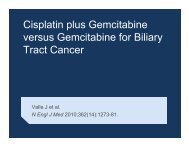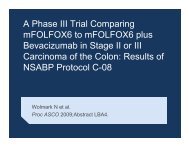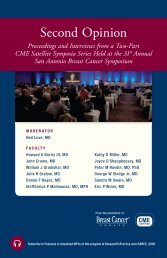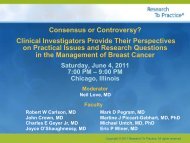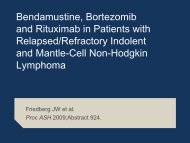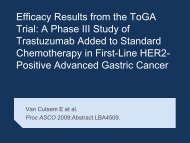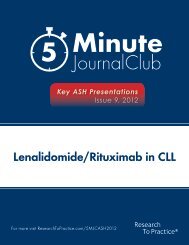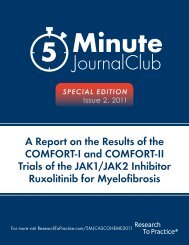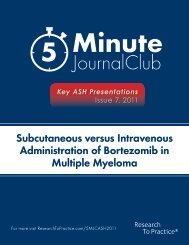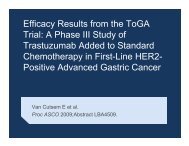Therapy for Primary Mediastinal B-Cell Lymphoma (PMBCL)
Downloadable PDF - Research To Practice
Downloadable PDF - Research To Practice
- No tags were found...
You also want an ePaper? Increase the reach of your titles
YUMPU automatically turns print PDFs into web optimized ePapers that Google loves.
Key ASH PresentationsIssue 6, 2011R-CHOP-14 Followed by ICEConsolidation without Radiation<strong>Therapy</strong> <strong>for</strong> <strong>Primary</strong> <strong>Mediastinal</strong>B-<strong>Cell</strong> <strong>Lymphoma</strong> (<strong>PMBCL</strong>)For more visit ResearchToPractice.com/5MJCASH2011
CME INFORMATIONOVERVIEW OF ACTIVITYThe annual American Society of Hematology (ASH) meeting is unmatched in its importance with regard to advancements in hematologiccancer and related disorders. It is targeted by many members of the clinical research community as the optimal <strong>for</strong>um in which to unveilnew clinical data. This creates an environment each year in which published results from a plethora of ongoing clinical trials lead to theemergence of many new therapeutic agents and changes in the indications <strong>for</strong> existing treatments across virtually all malignant andbenign hematologic disorders. As online access to posters and plenary presentations is not currently available, a need exists <strong>for</strong> additionalresources to distill the in<strong>for</strong>mation presented at the ASH annual meeting <strong>for</strong> those clinicians unable to attend but desiring to remain up todate on the new data released there. To bridge the gap between research and patient care, this CME activity will deliver a serial reviewof the most important emerging data sets from the latest ASH meeting, including expert perspectives on how these new evidence-basedconcepts can be applied to routine clinical care. This activity will assist medical oncologists and other cancer clinicians in the <strong>for</strong>mulation ofoptimal clinical management strategies <strong>for</strong> hematologic cancer.LEARNING OBJECTIVE• Recognize the rationale <strong>for</strong> avoidance of local radiation therapy in <strong>PMBCL</strong>, and summarize outcomes achieved with induction R-CHOPfollowed by ICE consolidation alone.ACCREDITATION STATEMENTResearch To Practice is accredited by the Accreditation Council <strong>for</strong> Continuing Medical Education to provide continuing medical education<strong>for</strong> physicians.CREDIT DESIGNATION STATEMENTResearch To Practice designates this educational activity <strong>for</strong> a maximum of 0.25 AMA PRA Category 1 Credits. Physicians should onlyclaim credit commensurate with the extent of their participation in the activity.HOW TO USE THIS CME ACTIVITYThis CME activity contains slides and edited commentary. To receive credit, the participant should review the slide presentation, read thecommentary and complete the Educational Assessment and Credit Form located at CME.ResearchToPractice.com.CONTENT VALIDATION AND DISCLOSURESResearch To Practice (RTP) is committed to providing its participants with high-quality, unbiased and state-of-the-art education. Weassess potential conflicts of interest with faculty, planners and managers of CME activities. Real or apparent conflicts of interest areidentified and resolved through a conflict of interest resolution process. In addition, all activity content is reviewed by both a member ofthe RTP scientific staff and an external, independent physician reviewer <strong>for</strong> fair balance, scientific objectivity of studies referenced andpatient care recommendations.FACULTY — The following faculty (and their spouses/partners)reported real or apparent conflicts of interest, which have beenresolved through a conflict of interest resolution process:Craig Moskowitz, MDClinical Director, Division of Hematologic OncologyMember, <strong>Lymphoma</strong> ServiceMemorial Sloan-Kettering Cancer CenterNew York, New YorkAdvisory Committee: Cephalon Inc, Genentech BioOncology,Seattle Genetics; Paid Research: Cephalon Inc, GenentechBioOncology, Lilly USA LLC, Plexxikon Inc, Seattle Genetics.EDITOR —Dr Love is president and CEO of Research To Practice,which receives funds in the <strong>for</strong>m of educational grants todevelop CME activities from the following commercial interests:Abraxis BioScience Inc, a wholly owned subsidiary of CelgeneCorporation, Allos Therapeutics, Amgen Inc, AstraZenecaPharmaceuticals LP, Aureon Laboratories Inc, Bayer HealthCarePharmaceuticals/Onyx Pharmaceuticals Inc, Biogen Idec,Boehringer Ingelheim Pharmaceuticals Inc, Bristol-Myers SquibbCompany, Celgene Corporation, Cephalon Inc, Daiichi Sankyo Inc,Dendreon Corporation, Eisai Inc, EMD Serono Inc, GenentechBioOncology, Genomic Health Inc, Lilly USA LLC, Millennium— The Takeda Oncology Company, Myriad Genetics Inc, NovartisPharmaceuticals Corporation, OSI Oncology, Sanofi-Aventis andSeattle Genetics.RESEARCH TO PRACTICE STAFF AND EXTERNAL REVIEWERS— The scientific staff and reviewers <strong>for</strong> Research To Practice haveno real or apparent conflicts of interest to disclose.This educational activity contains discussion of publishedand/or investigational uses of agents that are not indicated bythe Food and Drug Administration. Research To Practice doesnot recommend the use of any agent outside of the labeledindications. Please refer to the official prescribing in<strong>for</strong>mation<strong>for</strong> each product <strong>for</strong> discussion of approved indications,contraindications and warnings. The opinions expressed are thoseof the presenters and are not to be construed as those of thepublisher or grantors.This program is supported by educational grants from AllosTherapeutics, Celgene Corporation, Millennium — The TakedaOncology Company, Novartis Pharmaceuticals Corporation, OnyxPharmaceuticals Inc and Seattle Genetics.Last review date: March 2011Expiration date: March 2012
Key ASH PresentationsIssue 6, 2011Click here <strong>for</strong> ASH papers on MCL and DLBCL.Imagine you were given the opportunity to have one of the great figures in hematologiconcology visit your practice <strong>for</strong> a day, meet patients in your clinic and review theircases. Medical oncologist Dr Margaret Deutsch of Raleigh, North Carolina accepted thatchallenge and some months ago welcomed lymphoma maven and rock guitarist BruceCheson to the Tar Heel State as part of our Visiting Professors series. The veryfirst patient they met together typified a modern dilemma faced by both communitypractitioners and investigators. This otherwise-healthy 62-year-old woman presentedwith a benign-appearing submandibular lymph node that was initially treated withantibiotics but proved to be mantle-cell lymphoma (MCL). Further workup revealedextensive adenopathy in the neck and mediastinum.It’s disappointing that more than a decade after identifying the biologic alteration thatdifferentiates mantle-cell from the other lymphomas — t(11;14)(q13;q32) translocationleading to overexpression of cyclin D1 — we still have not found an imatinib/CMLlikesolution <strong>for</strong> this generally incurable disease. Dr Cheson — who seems to have
published a paper on every possible NHL subtype and issue — echoed this reality ashe immediately raised the possibility of participation in a clinical trial when discussingDr Deutsch’s patient following their meeting. He then rattled off a host of promisingbiologic agents, including the much-discussed PI3 kinase inhibitor CAL-101 and othersI had never heard of, like Bruton tyrosine kinase (BTK) inhibitors and BiTEs (bispecificT-cell engagers).Bruce also mentioned two important Phase III trials <strong>for</strong> newly diagnosed MCL:the planned Intergroup trial of pretransplant induction with either R-hyper-CVAD orBR (bendamustine/rituximab) and in the nontransplant setting — stealing a pagefrom myeloma — a proposed study featuring an initial randomization of BR versusBR/bortezomib with a second randomization to maintenance with either R orR/lenalidomide.Despite all this fascinating science and hope <strong>for</strong> the future, Dr Deutsch was still facedwith a young woman with a bad disease and no great solutions <strong>for</strong> today. As is oftenmy observation when community docs have investigators review their cases, Maggiealmost seemed relieved to know that one of the leading minds in the field didn’t reallyhave much more to offer this un<strong>for</strong>tunate patient.Below we review several ASH papers on mantle-cell and diffuse large B-cell lymphoma(DLBCL) that hopefully will help lead the way <strong>for</strong> the Oncotones to play happier tunes inthe future.1. European MCL Network trial: R-CHOP alternating with R-DHAP followed by highdoseAra-C prior to transplantThis high-profile study provided provocative data demonstrating a progression-freesurvival advantage to inclusion of high-dose Ara-C, and the authors concluded that this“should become the new standard of care <strong>for</strong> MCL patients up to 65 years.”2. Italian study of lenalidomide/dexamethasone in relapsed/refractory MCLIn this Phase II trial of 33 patients the objective response rate to salvage therapywas 67 percent, which is similar to that with lenalidomide alone. Interestingly, anincrease in bone marrow macrophage infiltration was observed, likely a result of theimmunomodulatory effect of lenalidomide, resulting in increased microvessel countsand suggesting a unique mechanism of “indirect angiogenesis.”3. SWOG Phase II trial of consolidation with radioimmunotherapy (RIT) after R-CHOPinduction <strong>for</strong> DLBCLThis disappointing study demonstrated that I-131 tositumomab did not seem to addmuch to outcome, although 27 percent of the patients never received RIT because ofearly relapse and induction treatment complications.4. Memorial trial in mediastinal large B-cell lymphomaThis Phase II study of 54 patients with a median age of 33 employed an initialnonradiation therapy approach of dose-dense R-CHOP followed by ICE/RICEconsolidation. Treatment failure occurred in 11 patients, but five are now progression
free after salvage autotransplant with radiation treatment. The authors believe thatradiation therapy may now be avoided up front, potentially sparing these youngerpatients the long-term sequelae of that treatment.Next up on this ASH highlights program: Part 2 of our myeloma update and the nextgeneration of IMiDs ® and proteasome inhibitors.Neil Love, MDResearch To PracticeMiami, FloridaResearch To Practice is accredited by the Accreditation Council <strong>for</strong> Continuing Medical Education toprovide continuing medical education <strong>for</strong> physicians.Research To Practice designates each educational activity <strong>for</strong> a maximum of 0.25 AMA PRACategory 1 Credits TM . Physicians should only claim credit commensurate with the extent of theirparticipation in each activity.This program is supported by educational grants from Allos Therapeutics, Celgene Corporation,Millennium — The Takeda Oncology Company, Novartis Pharmaceuticals Corporation, OnyxPharmaceuticals Inc and Seattle Genetics.Research To PracticeOne Biscayne Tower2 South Biscayne Boulevard, Suite 3600Miami, FL 33131This email was sent to you by Dr Neil Love and Research To Practice. To unsubscribe to futureemail requests and announcements, click here. To unsubscribe from all email communications,including CME/CNE activities sent by Research To Practice, click here.To update your in<strong>for</strong>mation on our current distribution lists, click here.
R-CHOP-14 Followed by ICE Consolidation without Radiation<strong>Therapy</strong> <strong>for</strong> <strong>Primary</strong> <strong>Mediastinal</strong> B-<strong>Cell</strong> <strong>Lymphoma</strong> (<strong>PMBCL</strong>)Presentation discussed in this issueMoskowitz C et al. Sequential dose dense R-CHOP followed by ICE consolidation(MSKCC protocol 01-142) without radiotherapy <strong>for</strong> patients with primarymediastinal B cell lymphoma. Proc ASH 2010;Abstract 420.Slides from a presentation at ASH 2010 and transcribed commentsfrom a recent interview with Craig Moskowitz, MD (1/3/11)For more visit ResearchToPractice.com/5MJCASH2011
For more visit ResearchToPractice.com/5MJCASH2011
For more visit ResearchToPractice.com/5MJCASH2011
For more visit ResearchToPractice.com/5MJCASH2011
For more visit ResearchToPractice.com/5MJCASH2011



